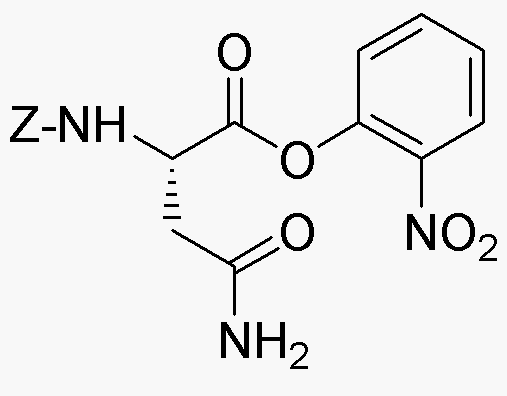Na-Z-L-asparagine 2-nitrophenyl ester is widely utilized in research focused on:
- Biochemical Research: This compound serves as a valuable substrate in enzyme assays, helping researchers study enzyme kinetics and mechanisms, particularly in amino acid metabolism.
- Drug Development: It is used in the synthesis of peptide-based pharmaceuticals, offering a pathway for creating compounds with enhanced bioactivity and specificity.
- Protein Engineering: The ester can be employed to modify proteins, aiding in the development of novel biocatalysts with improved stability and activity under various conditions.
- Analytical Chemistry: It acts as a standard in chromatographic techniques, allowing for accurate quantification of amino acids in complex mixtures, which is crucial for quality control in food and pharmaceutical industries.
- Educational Purposes: This compound is often used in academic laboratories for teaching purposes, providing students hands-on experience with organic synthesis and biochemical analysis.
General Information
Properties
Safety and Regulations
Applications
Na-Z-L-asparagine 2-nitrophenyl ester is widely utilized in research focused on:
- Biochemical Research: This compound serves as a valuable substrate in enzyme assays, helping researchers study enzyme kinetics and mechanisms, particularly in amino acid metabolism.
- Drug Development: It is used in the synthesis of peptide-based pharmaceuticals, offering a pathway for creating compounds with enhanced bioactivity and specificity.
- Protein Engineering: The ester can be employed to modify proteins, aiding in the development of novel biocatalysts with improved stability and activity under various conditions.
- Analytical Chemistry: It acts as a standard in chromatographic techniques, allowing for accurate quantification of amino acids in complex mixtures, which is crucial for quality control in food and pharmaceutical industries.
- Educational Purposes: This compound is often used in academic laboratories for teaching purposes, providing students hands-on experience with organic synthesis and biochemical analysis.
Documents
Safety Data Sheets (SDS)
The SDS provides comprehensive safety information on handling, storage, and disposal of the product.
Product Specification (PS)
The PS provides a comprehensive breakdown of the product’s properties, including chemical composition, physical state, purity, and storage requirements. It also details acceptable quality ranges and the product's intended applications.
Certificates of Analysis (COA)
Search for Certificates of Analysis (COA) by entering the products Lot Number. Lot and Batch Numbers can be found on a product’s label following the words ‘Lot’ or ‘Batch’.
*Catalog Number
*Lot Number
Certificates Of Origin (COO)
This COO confirms the country where the product was manufactured, and also details the materials and components used in it and whether it is derived from natural, synthetic, or other specific sources. This certificate may be required for customs, trade, and regulatory compliance.
*Catalog Number
*Lot Number
Safety Data Sheets (SDS)
The SDS provides comprehensive safety information on handling, storage, and disposal of the product.
DownloadProduct Specification (PS)
The PS provides a comprehensive breakdown of the product’s properties, including chemical composition, physical state, purity, and storage requirements. It also details acceptable quality ranges and the product's intended applications.
DownloadCertificates of Analysis (COA)
Search for Certificates of Analysis (COA) by entering the products Lot Number. Lot and Batch Numbers can be found on a product’s label following the words ‘Lot’ or ‘Batch’.
*Catalog Number
*Lot Number
Certificates Of Origin (COO)
This COO confirms the country where the product was manufactured, and also details the materials and components used in it and whether it is derived from natural, synthetic, or other specific sources. This certificate may be required for customs, trade, and regulatory compliance.


